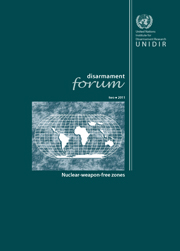Nuclear-weapon-free zones (NWFZs)—from the 1967 Treaty of Tlatelolco to the 2006 Treaty of Semipalatinsk—are an important and concrete contribution to the nuclear disarmament regime. There has been renewed interest in the establishment of new zones, with talk of a zone in the Arctic and in the Middle East. Progress with current NWFZs is also being made— the protocols to the Treaty of Pelindaba were submitted to the US Senate in May 2011 for consent to ratification, making the United States the final nuclear-weapon state to do so.
In this issue of Disarmament Forum authors examine positive contributions of NWFZs to regional and global security, developments on the African continent following the entry into force of the Treaty of Pelindaba, as well as the prospect of an Arctic NWFZ. Contributions also focus on the potential for a zone free of weapons of mass destruction in the Middle East, as the international community turns its attention to the 2012 conference on this issue.
Citation: Kerstin Vignard (ed.) (2011). "Disarmament Forum: Nuclear Weapon-Free Zones", UNIDIR, Geneva.
Disponible aussi en français.
Contents
- Editor’s note, Kerstin Vignard
- Peeling the orange: regional paths to a nuclear-weapon-free world, Michael Hamel-Green
- The Treaty of Pelindaba: towards the full implementation of the African NWFZ Treaty, Noël Stott
- The Arctic: top of the world to be nuclear-weapon-free, Jan Prawitz
- Possible elements of an NWFZ in the Middle East, Nabil Fahmy and Patricia Lewis
- The role of civil society in promoting a WMDFZ in the Middle East, Chen Kane
- UNIDIR focus
